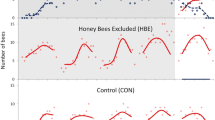Summary
When a honey bee forager returns to her hive and unloads nectar, she sometimes transfers her entire load to one bee, but other times she makes a series of unloadings to several bees. One intriguing hypothesis for why foragers make multiple unloadings is the Information Improvement hypothesis: multiple unloadings improve a forager’s estimate of the difficulty in finding a receiver bee, and thus of the allocation of labor between nectar collecting and nectar processing. In this paper, we discuss a possible weakness in the empirical evidence in support of the Information Improvement hypothesis. We also present a competing hypothesis, the Crop Fullness hypothesis: multiple unloadings arise from a mismatch between the amount of nectar a forager has to unload and the amount of nectar a receiver can imbibe. Finally, we test the two hypotheses by checking their predictions regarding the conditions under which multiple unloadings occur and which bee (forager or receiver) breaks off the first unloading when a forager makes multiple unloadings. We find that multiple unloadings are common only at times of high nectar influx and that most often it is the receiver, not the forager, who breaks off the first unloading. We argue that both of these findings are contradictory to the Information Improvement hypothesis but are consistent with the Crop Fullness hypothesis. Furthermore, we relate our findings to a recent theoretical study (Gregson et al., 2003) which shows, by means of a simulation model, that the level of multiple unloadings observed can be accounted for by a mismatch between the crop loads of foragers and the crop capacities of receiver bees. We combine our measurements with the Gregson et al. model to identify the rule used by receiver bees in deciding when to stop receiving more nectar. We conclude that receivers make this decision during the course of an unloading, not after completing an unloading. Finally, with this conclusion in hand, we test the Gregson et al. model by comparing predictions and observations on how full receivers are when they decide to break off an unloading. We find a remarkable agreement (prediction: 60%, observation: 52–59%), in strong support of the model.
Similar content being viewed by others
Author information
Authors and Affiliations
Corresponding author
Rights and permissions
About this article
Cite this article
Huang, M.H., Seeley, T.D. Multiple unloadings by nectar foragers in honey bees: a matter of information improvement or crop fullness?. Insectes Soc. 50, 330–339 (2003). https://doi.org/10.1007/s00040-003-0682-4
Received:
Accepted:
Issue Date:
DOI: https://doi.org/10.1007/s00040-003-0682-4




